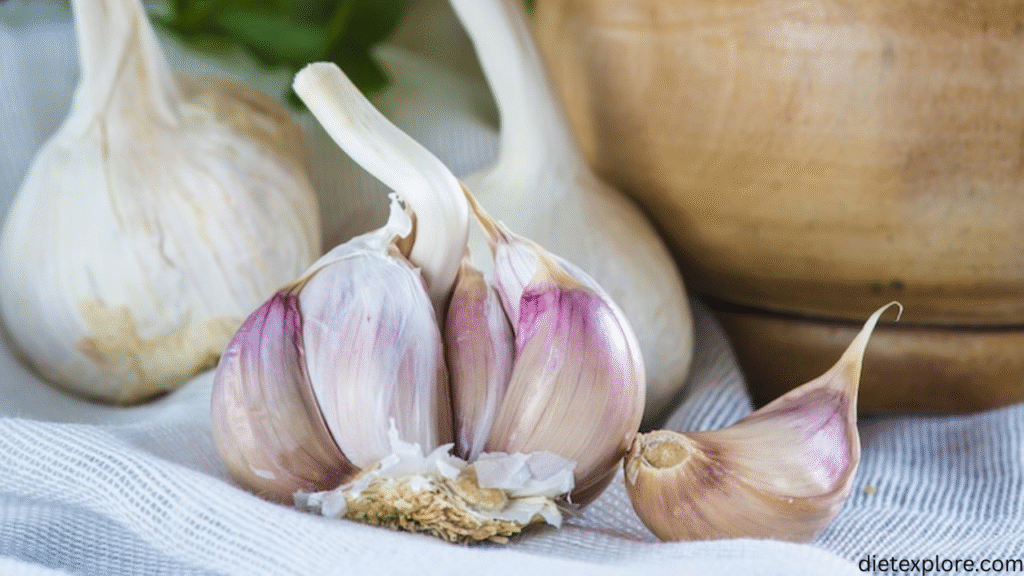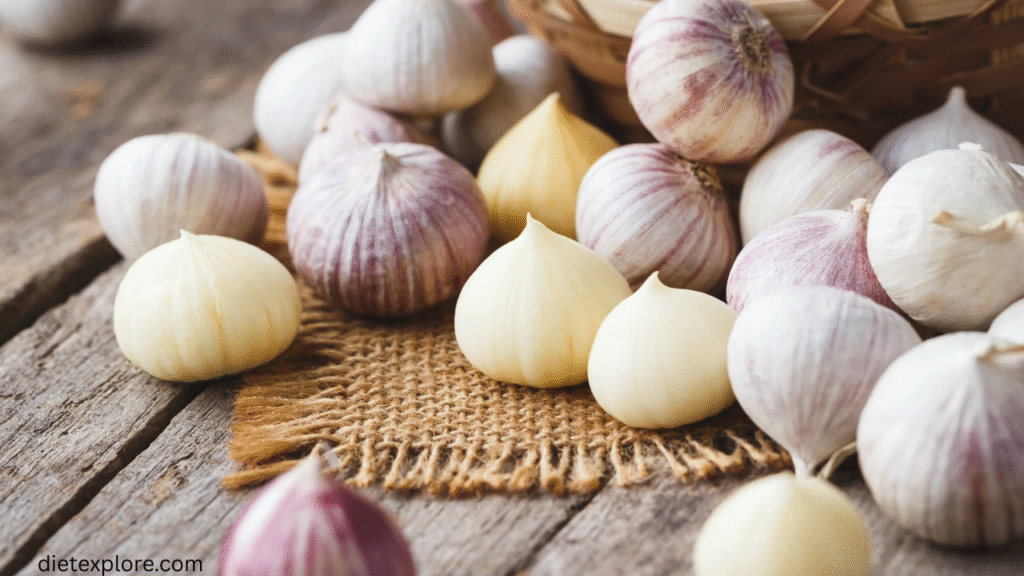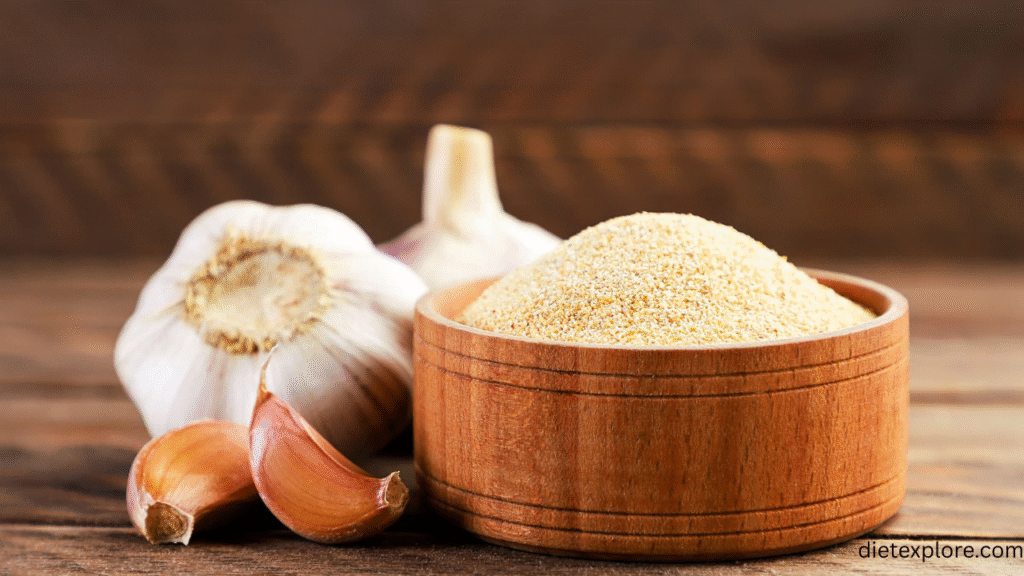Garlic Clove
Garlic Clove: Garlic, known scientifically as Allium sativum, is more than just a kitchen staple—it’s a powerful ingredient with a storied history and remarkable health credentials. Comprising several fleshy segments called cloves, garlic bulbs have been cultivated globally for millennia. Today, China accounts for roughly 73% of the world’s garlic production.
Enjoyed for its pungent aroma and complex flavor, garlic has a revered place in cuisines around the world. But beyond taste, garlic is packed with beneficial compounds, most notably sulfur-containing molecules like allicin, ajoene, and diallyl disulfide, which form when garlic is crushed or chopped. These compounds aren’t just aromatic—they provide the basis for garlic’s medicinal properties, including antimicrobial, antiviral, anti-inflammatory, and cardiovascular benefits.
In this article, we’ll explore what a garlic clove actually is, how to convert it to different forms like powder or minced, useful conversions between cloves and teaspoon measures, and its health benefits—all wrapped in a clean, SEO-friendly structure.
What Is a Garlic Clove?
A garlic clove is one of the small, fleshy segments that make up a garlic bulb. Typically, a bulb contains around 10–15 cloves. A single clove weighs approximately 3 grams and provides about 4.5 calories, along with trace amounts of protein, carbs, and essential micronutrients like manganese, vitamin B6, vitamin C, selenium, and fiber.
In culinary terms, garlic cloves are incredibly versatile. They can be used raw, imparting a sharp, pungent bite, or cooked, which mellows and sweetens their flavor. The famed compound allicin forms when a clove is cut or crushed, creating that characteristic aroma and offering multiple health-promoting actions—though it is unstable and degrades quickly.

Also Read: /sesame-oil/
Garlic Clove to Powder
Its Powder Form
Converting a garlic clove to garlic powder is essential when fresh cloves aren’t available or when shelf-stability is needed. Garlic powder is made by dehydrating garlic cloves until around 6.5% moisture remains, then milling them into fine powder.
In terms of replacement:
- 1 garlic clove ≈ 1/8 teaspoon of garlic powder.
For example, if a recipe calls for 3 cloves of garlic, you can use about 3/8 teaspoon of powder. It’s crucial to note that garlic powder is much more concentrated, so precise measuring is key for balanced flavor.
In summary, garlic powder is a convenient and long-lasting form of garlic. Remember: 1 clove = 1/8 tsp powder, a potent substitution to achieve similar flavor profiles.
Garlic Clove to Minced
Minced garlic offers maximal flavor release and convenience. Here’s how cloves convert when minced:
- 1 garlic clove ≈ ½ teaspoon of minced garlic.
- Some sources note that 1 medium clove yields 1 teaspoon chopped or slightly less when finely minced.
As per general kitchen guidelines:
- 1 garlic clove = ½ teaspoon minced.
- 2 = 1 teaspoon.
- 3 = 1½ teaspoons, and so on.
The takeaway? To replace one clove: use about ½ tsp minced garlic. This substitution works well with store-bought minced garlic in jars and maintains strong flavor. Keep in mind, more finely minced garlic may pack a flavor punch—start modest and adjust as needed.

Garlic Clove to Tsp
When recipes call for garlic in teaspoons, clarity is critical:
- 1 average clove = ½ teaspoon minced garlic.
- Some say 1 medium clove = 1 teaspoon chopped.
So:
- Chopped garlic: 1 clove ≈ 1 teaspoon.
- Minced garlic: 1 clove ≈ ½ teaspoon.
These measurements guide cooks switching between forms—whether using fresh, jarred, or another format. In short: if your recipe measures garlic in teaspoons, translate 1 clove to about ½ tsp minced or 1 tsp chopped, depending on the style.
1 Garlic Clove to Minced
A single garlic clove, when minced, typically yields:
- ½ teaspoon, per most cooking guidelines.
However, the size matters:
- Small clove: ~½ teaspoon.
- Medium clove: ~1 rounded teaspoon chopped, but slightly less if finely minced.
For jarred minced garlic, conversions often state:
- ½ tsp jarred minced = 1 fresh clove.
Thus:
- 1 garlic clove to minced = approximately ½ teaspoon, but depending on clove size, rounding up to 1 teaspoon chopped is sometimes acceptable if finely minced is unavailable.
1 Garlic Clove
To fully explore “1 garlic clove”, here’s a recap:
Nutritional content (for approx. 3 g clove):
- Calories: ≈ 4.5
- Fiber, protein, carbs: trace amounts
- Key micronutrients: manganese, vitamin B6, vitamin C, selenium
Culinary and health actions:
- When crushed, produces allicin, responsible for garlic’s aroma and many of its health effects.
- Also contains compounds like ajoene, with antimicrobial and antithrombotic properties.
Flavor:
- Raw clove delivers a pungent kick.
- Cooked, it mellows, offering a sweeter, nuanced flavor profile.
Use:
- 1 clove can be substituted in recipes as:
- ½ tsp minced
- 1 tsp chopped
- 1/8 tsp garlic powder
By embracing the versatility of 1 clove, cooks can adapt recipes while leveraging nutritional and flavor benefits.
1 Garlic Clove to Tsp
When converting 1 garlic clove to teaspoons:
- Minced garlic: ~½ teaspoon per clove.
- Chopped garlic: ~1 teaspoon per clove (especially for medium-sized ones).
So, the quick conversion table:
| Form | Approx. for 1 clove |
|---|---|
| Minced | ½ teaspoon |
| Chopped | 1 teaspoon |
| Garlic powder | 1/8 teaspoon |
These measures help streamline cooking and recipe adjustments while preserving both flavor and intention.

Garlic Clove Benefits
Benefits of garlic cloves:
- Rich in Sulfur Compounds – Crushing or chopping garlic yields allicin, a potent compound credited with antimicrobial, antiviral, and anti-inflammatory actions.
- Highly Nutritious – Per 3 g clove: ~4.5 calories with significant manganese, vitamin B6, vitamin C, selenium, and fiber.
- Immune System Support – Regular consumption may reduce the severity and duration of colds; aged garlic extract has been shown to lower sick days.
- Heart Health – Garlic may help lower blood pressure and cholesterol, and reduce atherosclerosis risk through anti-clotting properties.
- Antioxidant & Cellular Protection – Garlic antioxidants may protect cells from oxidative damage, helping reduce risks of chronic diseases, including neurodegeneration.
- Prebiotic Effects – Acts as a prebiotic, feeding beneficial gut bacteria and supporting digestive and mental health.
- Antimicrobial Properties – Disrupts bacterial, fungal, and even viral pathogens, offering a natural way to support defenses.
- Skin & Exterior Use – Topical garlic may help with acne or athlete’s foot due to antibacterial qualities—used with caution to avoid irritation.
- Blood Sugar Regulation – May improve insulin sensitivity and aid blood sugar control, relevant for managing diabetes risk.
- Detoxification – Helps stimulate detox mechanisms—particularly in the liver—and support clearance of heavy metals.
- It may also adds more benefits like:
Supports Bone Health – Garlic may help increase estrogen levels in women, which is linked to improved bone strength and reduced risk of osteoporosis.
Improves Athletic Performance – Historically, garlic was used by ancient cultures to reduce fatigue and boost endurance. Some studies suggest it may improve exercise capacity.
Conclusion
Garlic is a modest yet mighty part of the garlic bulb, delivering flavor, nutrition, and health-enhancing compounds in each small segment. Whether you’re converting a clove for cooking—½ teaspoon minced, 1 teaspoon chopped, or ⅛ teaspoon its powder—or using it for its antimicrobial, cardiovascular, immune-boosting, and antioxidant properties, it brings remarkable value from kitchen to wellness routine.
Consuming just one raw clove per day is often recommended to maximize benefits—but note cooking methods and timing can preserve key compounds like allicin.
That said, while garlic is powerful, it’s not a cure-all. Use it as part of a balanced diet, and consult healthcare professionals for medical concerns or supplement usage.
From its ancient roots to modern science, it continues to live up to its reputation: a humble clove with big flavor and even bigger potential.




